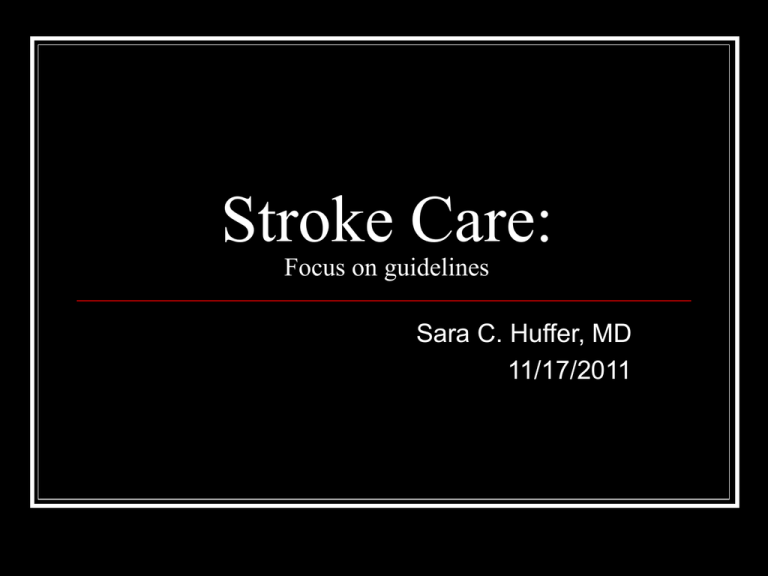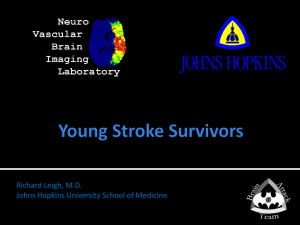AHA stroke guidelines
advertisement

Stroke Care: Focus on guidelines Sara C. Huffer, MD 11/17/2011 Background tPA for acute ischemic stroke Stroke mechanisms Guidelines for anticoagulation Summary Quality measures are increasingly used Quality, and not quantity, of care will drive reimbursement Multiple stakeholders interested in highest quality of care in setting of limited resources EIGHT CORE MEASURES 1. IV tPA 2. Stroke Education 3. Discharge on statin 4. DVT prophylaxis 5. Rehabilitation assessment 6. Anticoagulation for atrial fibrillation 7. Antithrombotics by hospital day #2 8. Antithrombotics at discharge 90 year old woman admitted with hip fracture found by her daughter at 9am to have aphasia and decreased movement of right side. What is the next step? ICU transfer Head CT now Call pharmacy and have them mix tPA Hope that everything will get better Have a snack; gather thoughts Head CT is without blood Neurology consult for acute stroke Thrombolysis decision: Assess for contraindications to therapy Discussion with family Risks/benefits Double-blinded Placebo controlled NIH-sponsored 0.9mg/kg IV t-PA 624 patients Treatment within 3 hours 1/2 within 90 minutes 1/2 within 91-180 minutes 0-1 2-3 4-5 Death Placebo 26% 25 27 21 t-PA 39% 21 23 17 NEJM 1995; 333:1581-7. 0: No symptoms at all • 1: No significant disability despite symptoms; able to carry out all usual duties and activities _____________ • 2: Slight disability; unable to carry out all previous activities, but able to look after own affairs without assistance • 3: Moderate disability; requiring some help, but able to walk without assistance _____________ • 4: Moderately severe disability; unable to walk without assistance and unable to attend to own bodily needs without assistance • 5: Severe disability; bedridden, incontinent and requiring constant nursing care and attention ____________ • 6: Dead • Placebo Group tPA Group “When was the last time you saw him/her totally normal?” How “normal” were they? Who saw them this morning? Clearly no symptoms? Times of reference “When the Colts game started” Time (min) Odds Ratio (Favorable Outcome) 95% CI 0-90 2.8 1.8-4.5 91-180 1.5 1.1-2.1 181-270 1.4 1.1-1.9 271-360 1.2 0.9-1.5 Lancet 2004; 363: 768–74 Lancet 2004; 363: 768–74 N Engl J Med 2008;359:1317-1329. An American Heart Association/American Stroke Association science advisory group has recommended the use of t-PA in the 3 to 4.5 hour window. The advisory committee emphasizes the importance of treating acute strokes as rapidly as possible. The extended time window should not lead to any delay in treating eligible patients. Case patient 90 year old woman admitted with hip fracture found by her daughter at 9am to have aphasia and decreased movement of right side. Nursing notes indicate patient was last seen normal 15 minutes earlier when the neurologist was called (60 minutes ago now). BP >185/110 or aggressive BP lowering measures Any history of intracranial hemorrhage Symptoms of SAH Active bleeding or known bleeding disorder Plt<100, high PTT, INR >1.7 H/o ischemic stroke, neurosurgery or serious head trauma within 3 months • • • • • • • • • Major surgery/trauma within 14 days Gastrointestinal/urinary hemorrhage within 21 days Arterial puncture at a noncompressible site within 7 days LP within 7 days Recent MI (with sx/signs of pericarditis) Seizure at onset Known AVM or aneurysm Glucose < 50 or >400 Rapidly improving or minor symptoms Common and natural consequence of infarction 43% HT rate at 4 weeks in natural hx studies Risk of severe HT increases with rt-PA (and all revascularization therapies) 6.4% risk in NINDS (compared to 0.6% in placebo) Increased risk with older age and large strokes, but still overall benefit Khatri, Stroke, 2007 Case patient 90 year old woman admitted with hip fracture found by her daughter at 9am to have aphasia and decreased movement of right side. Nursing notes indicate patient was last seen normal 15 minutes earlier when the neurologist was called (60 minutes ago now). Accucheck was 85, blood pressure was 170/96. She has no history of major bleeding Relative contraindication of trauma/surgery and age. Orthopedic surgeon felt it an acceptable risk to proceed with tPA. Prior to today she was independent at home and a church pianist. Family felt that patient would have wanted to take the risk to avoid severe debility. Emergent management • • • • • • • Nursing at bedside, may need to contact clinical supervisor Do NOT wait for ICU transfer Accucheck STAT labs – BMP, CBC, Coags, Cardiac markers – No need to wait for results unless clinical concern If BP>185/110 – Start gentle: Labetolol 10mg IV, may repeat x 1 Discuss w/family – no consent needed for standard IV rt-PA Foley catheter (if need anticipated after tPA) Call pharmacy to order t-PA; 0.9 mg/kg, 10% bolus – If not used, Genentech will reimburse Transfer to ICU for at least 24 hours No anticoagulants, antiplatelets, etc BPs less than 180/105 Blood sugars less than 200 Generally NPO ‘Safety’ HCT at 24 hours IVF: NS (no D5) HCT for headache, N/V, drowsiness, abrupt neurological decline TIME ZERO = ARRIVAL TO ED Seen by physician < 10 minutes Tx’ing physician notified <15 min CT scan <25 min Interpretation <45 min IV rt-PA started <60 min Earlier=better Marler, NINDS/NIH, 1997. Background tPA for acute ischemic stroke Stroke mechanisms Guidelines for anticoagulation Summary Ischemic stroke mechanisms Embolic Thrombotic Cardio-embolic Artery-artery embolic Atherosclerotic Small vessel disease Hemodynamic failure, “watershed” Cardioembolic Atrial fibrillation Acute MI and LV thrombus Cardiomyopathy Native valvular heart disease Prosthetic heart valves Artery to Artery Embolism 15-20% of all ischemic strokes Carotid stenosis Vertebral, intracranial arteries, aorta Background tPA for acute ischemic stroke Stroke mechanisms Guidelines for anticoagulation Summary Common misconceptions All patchy or wedge shape infarcts are embolic All “embolic” infarcts require anticoagulation Anticoagulation should be performed urgently after ischemic stroke to prevent worsening or further strokes AHA/ASA guidelines on urgent anticoagulation • Urgent anticoagulation, with the goal of preventing early recurrent stroke, halting neurological worsening or improving outcomes after acute ischemic stroke is not recommended for treatment of patients with acute ischemic stroke, (Class III, Level of Evidence A) • Urgent anticoagulation is not recommended for patients with moderate to severe strokes because of an increased risk of serious intracranial hemorrhagic complications (Class III, Level of Evidence A). Common misconceptions Anticoagulation should be performed urgently after ischemic stroke to prevent worsening or further strokes NO Heparin is a common source of medication error in stroke patients Due to unpredictable pharmacokinetics, need for frequent lab testing and dose changes, and continuous infusion. Michaels et al, “Medication errors in acute cardiovascular and stroke patients: A scientific statement from the American Heart Association”. Circulation, 2010. Cardioembolic Stroke Secondary prevention Atrial fibrillation Vitamin K antagonist If unable, use aspirin alone Aspirin-Plavix combo causes bleeding risk similar to warfarin Acute MI and LV thrombus Cardiomyopathy Native valvular heart disease Prosthetic heart valves Artery-artery embolism Carotid stenosis Antiplatelet therapy Statin therapy and risk factor modification CEA if indicated Intracranial atherosclerosis Aspirin instead of warfarin (Class I, level B) Angioplasty or stent placement is investigational PFO Present in 15-25% of population AHA guidelines: Insufficient data whether anticoagulation is equivalent to or superior to aspirin in secondary stroke prevention Metaanalysis of retrospective studies: PFO was associated with increased risk of stroke in age group <55 years Odds ratio 3.1 for PFO alone, 15.5 with atrial septal aneurysm Overell. Neurology. 2000 PFO studies PFO in cryptogenic stroke study 34% had PFO No difference in 2 year outcome in PFO vs. no PFO No difference in 2 year outcome asprin vs. warfarin European PFO study 2.3% recurrence with PFO 15% recurrence with PFO +atrial septal aneurysm 4.2% recurrence with neither Homma et al. Circulation, 2002 Mas et al. NEJM, 2001 Background tPA for acute ischemic stroke Stroke mechanisms Guidelines for anticoagulation Summary Quality measures are becoming more prevalent tPA for acute stroke is the standard of care Guidelines exist for decision to anticoagulate, based on risk factors More trials are needed on PFO and stroke Reference Furie, et al. Guidelines for the Prevention of Stroke in Patients With Stroke or Transient Ischemic Attack: A Guideline for Healthcare Professionals From the American Heart Association/American Stroke Association. Stroke. 2011;42:227276. Or google “AHA stroke guidelines” Sara Huffer, MD IU Health Arnett shuffer@iuhealth.org






